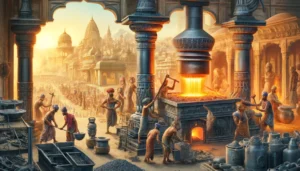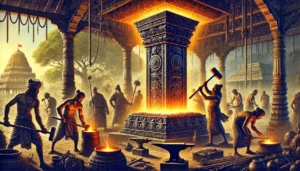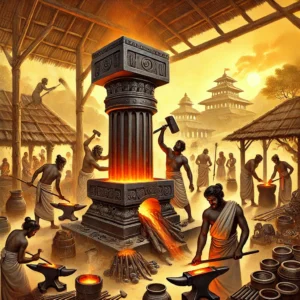
Why ancient Indian iron pillars never rust
How Ancient Indians Created Iron Pillars That Resist Rust
The metallurgical skills of ancient India have long fascinated historians, engineers, and scientists. One of the most remarkable achievements in this field is the creation of rust-resistant iron pillars, which have endured the test of time for over a millennium without significant corrosion. The Iron Pillar of Delhi, dating back to the Gupta Empire (4th–5th century CE), is the most famous example. Despite being exposed to the elements for centuries, it remains largely free of rust.
How did ancient Indian metallurgists achieve this? What scientific principles did they unknowingly employ to create these corrosion-resistant structures? In this article, we will explore the science, history, and techniques behind these extraordinary iron pillars.
The Iron Pillar of Delhi: An Engineering Marvel
A Brief History
The Iron Pillar of Delhi, located in the Qutub Minar complex, stands 7.3 meters (24 feet) tall and weighs approximately 6 tons. It was originally erected in Udayagiri (Madhya Pradesh) and later moved to its current location. The inscriptions on the pillar indicate that it was commissioned by Chandragupta II (Vikramaditya) of the Gupta dynasty in honor of the Hindu god Vishnu.
Despite standing outdoors for over 1,600 years, the pillar has remained largely corrosion-free. Scientists and metallurgists from around the world have studied it to uncover the secret behind its rust resistance.
Table of Contents

Why ancient Indian iron pillars never rust
Secrets Behind the Rust Resistance of Indian Iron Pillars
1. High Purity Wrought Iron
Modern steel production involves various impurities like sulfur and manganese, which can make iron more susceptible to rust. However, ancient Indian blacksmiths produced wrought iron with high purity.
The iron pillar contains almost no sulfur or manganese, reducing the chances of rust formation.
The low carbon content (less than 0.15%) prevents the formation of brittle phases, making the iron more durable.
2. Presence of Phosphorus Instead of Lime
Ancient Indian metallurgists did not use lime (CaO) in their iron-smelting process, which is a common practice in modern steelmaking. Instead, they used high-phosphorus iron ore, which contributed to the pillar’s longevity.
The iron pillar has a phosphorus content of about 0.25%, which is significantly higher than modern iron.
Phosphorus helps in forming a protective passive layer of iron oxides and phosphates, preventing further rusting.
3. Formation of a Protective Rust Layer
The key factor in the pillar’s resistance to rust is the formation of a protective layer called misawite (δ-FeOOH), a stable iron oxide-hydroxide enriched with phosphorus.
This layer prevents moisture and oxygen from reaching the inner layers of iron, thereby stopping rust formation.
Unlike normal rust, which flakes off and exposes fresh metal, this layer remains intact, offering long-term protection.
4. Traditional Forge-Welding Techniques
Instead of casting the pillar in one piece, ancient Indian blacksmiths used a forge-welding technique:
Small pieces of hot iron were hammered together, eliminating weak points and increasing the durability of the pillar.
This process refined the grain structure of the iron, making it more resistant to corrosion.
5. Favorable Environmental Conditions
While the metallurgy plays a crucial role, the climatic conditions in Delhi also contribute to the pillar’s longevity:
The low humidity and minimal rainfall reduce exposure to moisture, slowing down rust formation.
The presence of atmospheric pollutants like sulfur dioxide, which can accelerate rusting, was much lower in ancient times.
Other Rust-Resistant Iron Pillars and Structures in India
While the Delhi Iron Pillar is the most well-known, it is not the only example of India’s advanced iron-making skills. Several other rust-resistant iron structures exist across the country:
1. The Dhar Iron Pillar (Madhya Pradesh)
Located in Dhar, this iron pillar is believed to date back to the 11th century.
It stands about 13 feet tall and has also shown remarkable resistance to rust.
2. The Kodachadri Iron Pillar (Karnataka)
Found in the Mookambika Temple, this iron pillar is another example of India’s metallurgical heritage.
It has remained intact for centuries, despite being located in a more humid environment.
3. The Iron Beams of Konark Sun Temple (Odisha)
The famous Konark Sun Temple, built in the 13th century, features massive iron beams in its structure.
These iron beams have survived for over 700 years, resisting corrosion despite being exposed to coastal humidity.
4. The Iron Pillar of Mandu (Madhya Pradesh)
This iron pillar, dating back to the 13th century, stands tall without significant rusting.
These structures prove that the Delhi Iron Pillar was not an isolated phenomenon, but part of a broader tradition of advanced metallurgy in ancient India.

Why ancient Indian iron pillars never rust
Ancient Indian Metallurgy: A Lost Science?
The ability to produce rust-resistant iron pillars suggests that ancient Indian blacksmiths had an advanced understanding of materials science. Their expertise in:
Extracting pure iron from ore
Adding phosphorus to prevent corrosion
Using forge-welding techniques to increase strength
Encouraging the formation of protective oxide layers
shows that metallurgy in ancient India was far ahead of its time.
India was also famous for producing Wootz steel, a high-quality steel used to make legendary Damascus swords. These swords were known for their strength, flexibility, and sharpness and were highly sought after in the Middle East and Europe.
However, much of this ancient knowledge was lost due to foreign invasions and colonial rule. Modern metallurgists are now studying these ancient techniques to understand how they can be applied to modern materials science.
Modern Applications and Lessons from Ancient Indian Metallurgy
Scientists and engineers are now looking at the principles behind the rust-resistant iron pillars to develop:
Eco-friendly corrosion-resistant materials for modern infrastructure.
Stronger and more durable iron alloys for construction and transportation.
Rust-resistant coatings inspired by misawite for bridges, ships, and automobiles.
By studying the past, we can learn valuable lessons in sustainability, durability, and engineering.
Conclusion
The rust-resistant iron pillars of India are a testament to the brilliance of ancient Indian metallurgy. Their scientific composition, forge-welding techniques, and protective oxide layers allowed them to remain intact for over 1,600 years. These structures reflect not only India’s rich scientific heritage but also its mastery of engineering and materials science.
As researchers continue to uncover the secrets of these iron pillars, they provide inspiration for modern technology, proving that ancient wisdom still holds valuable lessons for the future.
The knowledge of our ancestors, if revived and adapted, could revolutionize modern metallurgy and engineering. The iron pillars stand as a reminder of India’s lost scientific heritage, waiting to be rediscovered and celebrated.
FAQs on The Ancient Indian Science Behind Rust-Resistant Iron Pillars
1. What makes the ancient Indian iron pillars rust-resistant?
The rust-resistant nature of these pillars, like the famous Iron Pillar of Delhi, is due to a unique combination of high-phosphorus content, low sulfur, and carbon in the iron. The ironworkers of ancient India used a special process called “forge welding” and did not add lime, which prevented the formation of rust-prone compounds.
2. How old is the Iron Pillar of Delhi, and where was it made?
The Iron Pillar of Delhi is believed to be over 1,600 years old, dating back to the Gupta period (4th–5th century CE). Some scholars suggest it was originally crafted in Udayagiri (Madhya Pradesh) and later moved to Delhi by a ruler.
3. What metal composition prevents rusting in these iron pillars?
These iron pillars contain:
High phosphorus (about 0.1%–0.25%): Forms a protective passive layer on the surface.
Low sulfur and carbon: Prevents brittleness and corrosion.
Presence of slag (iron impurities): Helps in weather resistance.
4. What is the role of the protective iron oxide layer?
A thin, stable layer of misawite (δ-FeOOH), a type of iron oxide-hydroxide, forms on the pillar’s surface, preventing further oxidation. This is different from modern rust, which flakes away, exposing fresh metal to corrosion.
5. Were other rust-resistant iron structures made in ancient India?
Yes! Several other iron pillars and structures exist, such as:
Dhar Iron Pillar (Madhya Pradesh) – Similar to the Delhi pillar but lesser known.
Kodachadri Iron Pillar (Karnataka) – Found near an ancient temple.
Iron beams in Konark Sun Temple (Odisha) – Used in the temple’s construction.
6. How did ancient Indians achieve such advanced metallurgy?
Ancient Indian metallurgists had mastered techniques like:
Wootz steel production (used to make Damascus swords).
Forge welding (joining heated iron pieces).
High-temperature smelting in furnaces with carefully controlled compositions.
7. Can modern science replicate this corrosion-resistant technology?
Modern metallurgy has advanced methods like stainless steel and weathering steel, but replicating the exact process and long-term corrosion resistance of these ancient iron pillars remains a challenge. The traditional techniques and materials used by ancient Indian blacksmiths are still being studied.
8. Why is this an important part of Indian heritage?
These iron pillars showcase India’s ancient scientific knowledge, craftsmanship, and engineering excellence. They are a testament to India’s early advancements in metallurgy, which influenced metalworking techniques worldwide.
Summary
The Ancient Indian Science Behind Rust-Resistant Iron Pillars
The rust-resistant iron pillars of ancient India stand as remarkable testaments to the metallurgical advancements achieved by Indian blacksmiths over a thousand years ago. The most famous among them, the Iron Pillar of Delhi, has baffled scientists and historians alike due to its extraordinary resistance to corrosion despite being exposed to the elements for over 1,600 years. This article delves into the intricate science, historical significance, and advanced techniques used by ancient Indian metallurgists to craft these enduring iron structures.
The Mystery of the Iron Pillar of Delhi
The Iron Pillar of Delhi, located in the Qutb Complex, is a 7.2-meter-high structure weighing around 6,000 kilograms. Its inscriptions suggest it was originally erected by King Chandragupta II (c. 375–415 CE) in honor of Lord Vishnu. What makes this pillar truly extraordinary is its ability to resist rust and degradation despite centuries of exposure to rain, humidity, and pollution.
Metallurgical analysis reveals that the pillar is composed of nearly pure wrought iron with an unusually high phosphorus content. Unlike modern iron, which often contains sulfur and manganese, the ancient ironworkers deliberately avoided these elements, making the metal more resistant to environmental corrosion.
Advanced Metallurgical Techniques of Ancient India
Ancient Indian blacksmiths used a unique process known as forge welding to create large iron structures. Instead of melting iron in blast furnaces, they heated iron ore in a low-oxygen, high-carbon environment—a technique that produced a material rich in slag (a byproduct containing phosphorus, silica, and carbon). The iron was then hammered and joined repeatedly, creating a more uniform, corrosion-resistant structure.
One of the key factors in rust resistance is the formation of a thin, protective passive layer of iron oxide and phosphorus on the surface of the pillar. This layer, known as misawite, is hydrophobic and prevents moisture from reaching the underlying metal, thereby reducing the rate of corrosion. Unlike modern iron, which forms flaky rust that spreads and weakens the structure, this protective layer remains stable for centuries.
Role of Phosphorus in Corrosion Resistance
Modern steel production involves removing phosphorus from iron, as it can make the metal brittle. However, ancient Indian metallurgists recognized that phosphorus played a crucial role in corrosion resistance. The iron pillars contain about 0.25% phosphorus, a level significantly higher than in modern steels. This phosphorus-rich composition reacts with oxygen and moisture to create an impervious film, further protecting the iron from degradation.
Other Examples of Rust-Resistant Iron in India
While the Delhi Iron Pillar is the most well-known, it is not the only example of India’s ancient metallurgical prowess. Other rust-resistant iron structures include:
The Dhar Iron Pillar (Madhya Pradesh) – Similar in composition to the Delhi Iron Pillar, this structure has also withstood the test of time.
The Konark Sun Temple Iron Beams (Odisha) – The massive iron beams used in the construction of the Sun Temple have remained largely corrosion-free.
The Iron Pillars of Kodachadri Hills (Karnataka) – These lesser-known iron structures further validate the advanced ironworking techniques of ancient India.
Comparing Ancient Indian Iron with Modern Corrosion-Resistant Metals
Today, modern industries use stainless steel and galvanized iron to combat rust. However, these require chromium, nickel, or zinc coatings, whereas ancient Indian iron resisted corrosion naturally without any external protective layers. In contrast, modern mild steel, if left unprotected, can corrode rapidly, often within a few years.
Legacy and Influence of Ancient Indian Metallurgy
The knowledge of iron-making in ancient India was far ahead of its time. Several historical texts, such as the Arthashastra (by Kautilya) and the Rasaratna Samuccaya, mention metallurgical techniques that emphasize iron purification, alloying, and preservation. India’s iron production techniques influenced global metallurgy, particularly through trade with the Middle East and Southeast Asia.
Conclusion
The rust-resistant iron pillars of India showcase an advanced understanding of metallurgy that was unparalleled in the ancient world. Through intelligent material selection, meticulous forging techniques, and an understanding of natural protective coatings, Indian blacksmiths created iron structures that have endured for centuries without significant corrosion. These pillars stand as symbols of India’s scientific ingenuity and continue to inspire metallurgists and engineers today.
Unlock the Ancient Wisdom of Sanatan Dharma – Join Us on YouTube!
👉 Subscribe now to Prachin Sanatan Dharma and embark on a journey of enlightenment.
Explore timeless teachings, spiritual insights, and cultural richness on our YouTube channel, Prachin Sanatan Dharma. Dive deep into the essence of Sanatan Dharma through captivating videos that inspire and educate.
Related Articles
- Restful Nights: Ayurvedic Remedies and Traditional Indian Practices to Overcome Insomnia and Late-Night Habits
- The Tridevi: Lakshmi, Saraswati, and Parvati – Their Roles and Powers
- “Divine Creatures of Ancient Indian Scriptures: Exploring the Role of Animals in the Vedas, Puranas, and Mahabharata”
- Nature and Spirituality: Exploring the Sacred Essence of the Himalayas, Ganga, and Other Natural Wonders”
- “Reviving the Gurukul System: Relevance and Lessons for Modern Education”
- “Exploring Greek and Indian Mythology: Similarities Between Greek and Indian Mythology “
- “Embracing Sattvic Living: Harmonizing Mind, Body, and Soul Through Food and Lifestyle”
- “Charity and Prosperity: Exploring the Concept of Daan and Its Financial Relevance in Modern Life”
- How to Build an Eco-Friendly Home Inspired by Vastu Shastra
- Comparison of Ancient and Modern Sports: How Traditional Sports Have Influenced Contemporary Games
- “Timeless Lessons from Ancient Tales: Linking Samudra Manthan and Ganga’s Descent to Modern Ecological Challenges”
- “Reviving Sanskrit: How AI is Preserving Ancient Languages for the Future”
- “Mathura: The Sacred Land of Lord Krishna’s Divine Leelas”
- Investing for Future Generations: Lessons from Indian Traditions on Legacy Building and Wealth Preservation
- “Ancient Indian Wisdom: Timeless Lessons for Tackling Today’s Climate Crisis”
- “Artificial Intelligence and Spirituality: Transforming Ancient Practices for the Modern World”
- “Gold and Real Estate in India: Timeless Assets Shaping Financial Strategies”
- Tradition Meets Innovation: The Evolution of Technology in Hindu Rituals
- End-of-World Myths: Exploring Kali Yuga in Hinduism and Ragnarök in Norse Mythology
- Garuda, Pegasus, and Dragons: The Universal Ties of Mythical Beasts Across Cultures
- “Ancient Vimanas: Mythical Flying Machines or Evidence of Advanced Technology?”
- Time Travel in Hindu Mythology: The Fascinating Tales of Kakudmi and King Raivata
- “Divine Feminine Power in Hindu Mythology: The Legends of Durga, Saraswati, and Lakshmi”
- “Divine Beings of Sanatan Dharma: The Spiritual Significance of Sacred Animals in Hinduism”
- “Symbolism in Mythological Art: Unlocking Hidden Meanings in Ancient Temple Carvings”
- “Exploring Technological Advancements in Ancient India and Civilizations: Vimana, Metallurgy, & Water Management systems”
- Unveiling the Mysteries: Ancient Temples of Sanatan Dharma , Mysterious Temples of India
- “The Scientific Knowledge of Sanatan Dharma: Ancient Wisdom Meets Modern Science”
- Ancient Indian Sports and Games: Celebrating a Legacy of Skill, Strength & Strategy”
- “Exploring the Cosmic Link: The Connection Between Astronomy and Vedic Astrology”
- The Power of Sanskrit: Unlocking the Divine Language of the Gods
- “The End of Kaliyuga: A Sanatan Insight into the World’s Final Chapter”
- Explore more articles on Prachin Sanatan Yuga.
Why ancient Indian iron pillars never rust Why ancient Indian iron pillars never rust Why ancient Indian iron pillars never rust Why ancient Indian iron pillars never rust Why ancient Indian iron pillars never rust Why ancient Indian iron pillars never rust Why ancient Indian iron pillars never rust Why ancient Indian iron pillars never rust Why ancient Indian iron pillars never rust
Why ancient Indian iron pillars never rust Why ancient Indian iron pillars never rust Why ancient Indian iron pillars never rust Why ancient Indian iron pillars never rust Why ancient Indian iron pillars never rust Why ancient Indian iron pillars never rust Why ancient Indian iron pillars never rust Why ancient Indian iron pillars never rust Why ancient Indian iron pillars never rust
Why ancient Indian iron pillars never rust Why ancient Indian iron pillars never rust Why ancient Indian iron pillars never rust Why ancient Indian iron pillars never rust Why ancient Indian iron pillars never rust Why ancient Indian iron pillars never rust Why ancient Indian iron pillars never rust Why ancient Indian iron pillars never rust Why ancient Indian iron pillars never rust
